BC: BLUEDOT FLAGS CV-19 IN DECEMBER 2019
..
..
..
..
..
..
..
..
..
..
..
..
..
..
..
..
..
..
..
..
..
..
When you're fighting a pandemic, almost nothing matters more than speed. A little-known band of doctors
and hi-tech wizards say they were able to find the vital speed needed to attack the coronavirus: the
computing power of artificial intelligence. They call their new weapon "outbreak science." It could change
the way we fight another contagion. Already it has led to calls for an overhaul of how the federal
government does things. But first, we'll take you inside BlueDot, a small Canadian company with an
algorithm that scours the world for outbreaks of infectious disease. It's a digital early warning system, and it
was among the first to raise alarms about this lethal outbreak.
It was New Year's Eve when BlueDot's computer spat out an alert: a Chinese business paper had just
reported 27 cases of a mysterious flu-like disease in Wuhan, a city of 11 million. The signs were ominous.
Seven people were already in hospitals.
Almost all the cases came from the city's sprawling market, where live animals are packed in cages and
slaughtered on-site. Medical detectives are now investigating if this is where the epidemic began, when the
virus made the leap from animals to us.
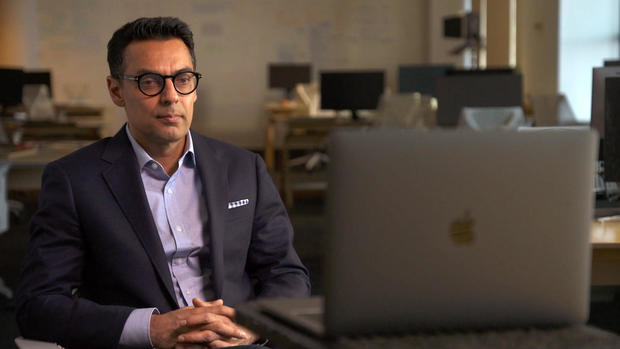
Dr. Kamran KhanHalf a world away on the Toronto waterfront, BlueDot's founder and CEO, Dr. Kamran
Khan, was on his way to work. An infectious disease physician, he had seen another coronavirus in 2003
– SARS – kill three colleagues. When we spoke with him remotely he told us this outbreak had him
worried.
Dr. Kamran Khan: We did not know that this would become the next pandemic. But we did know that there
were echoes of the SARS outbreak, and it was something that we really should be paying attention to.
COVID-19 soon got the world's attention. BlueDot's Toronto staff now works from home, except for Dr.
Khan. But in December, the office kicked into high-gear as they rushed to verify the alert.
Chinese officials were secretive about what was happening. But BlueDot's computer doesn't rely on official
statements. Their algorithm was already churning through data, including medical bulletins, even livestock
reports, to predict where the virus would go next.
It was also scanning the ticket data from 4,000 airports.
BlueDot wasn't just tracking flights, but calculating the cities at greatest risk. On December 31, there were
more than 800,000 travellers leaving Wuhan, some likely carrying the disease.

Dr. Kamran Khan: So these yellow lines reflect the nonstop flights going out of Wuhan. And then the blue
circles reflect the final destinations of travelers. The larger the circle, the larger number of travelers who are
going to that location. These were many of the first cities that actually received cases of COVID-19 as it
spread out of mainland China.
Bill Whitaker: You can do that in a matter of seconds?
Dr. Kamran Khan: We can analyze and visualize all this information across the globe in just a few seconds.
The virus wasn't just spreading to east Asia. Thousands of travelers were heading to the United States too.
Dr. Kamran Khan: Most of the travel came into California and San Francisco and Los Angeles. Uh, also,
into New York City. And we analyzed that way back on December 31. Our surveillance system that picked
up the outbreak of Wuhan automatically talks to the system that is looking at how travelers might go to
various airports around Wuhan.
Bill Whitaker: So when you see that map, you don't just see flight patterns?
Dr. Kamran Khan: If you think of an outbreak a bit like a fire and embers flying off, these are like embers
flying off into different locations.
Bill Whitaker: So in this case, that ember landed in dry brush in New York and started a wildfire?
Dr. Kamran Khan: Absolutely.
Dr. Khan told us he had spent the better part of a year persuading the airlines to share their flight data for
public health. Nobody had ever asked that before. But he saw it as information gold.
Dr. Kamran Khan: How is it that someone knows 16B - that seat is available, but 14A has been taken?
There clearly must be some kind of information system.
Bill Whitaker: Why is that so important?
Dr. Kamran Khan: There are over 4 billion of us that board commercial flights and travel around the world
every year. And so that is why understanding population movements becomes so important in anticipating
how disease is spread.
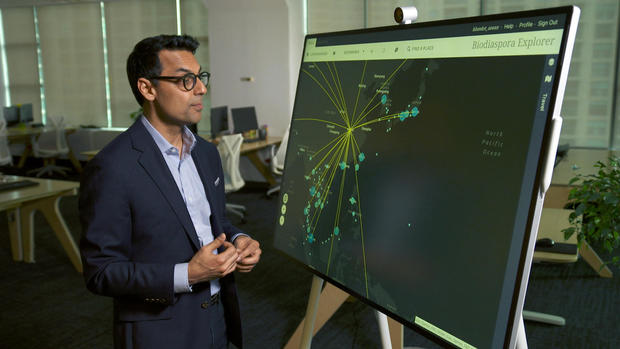
Dr. Kamran KhanThe virus spread across Asia with a vengeance. BlueDot has licensed access to the
anonymized location data from millions of cellphones. And with that data it identified 12 of the 20 cities that
would suffer first.
Dr. Kamran Khan: What we're looking at here are mobile devices that were in Wuhan in the previous 14
days and where are they now across East Asia. Places like Tokyo have a lot of devices, Seoul in South
Korea--
Bill Whitaker: So you're following those devices from Wuhan to these other cities?
Dr. Kamran Khan: That's correct. I do wanna point out these are also anonymized data. But they allow
us to understand population movements. That is how we can understand how this virus will spread.
To build their algorithm, Dr. Khan told us he deliberately hired an eclectic mix: engineers, ecologists,
geographers, veterinarians all under one roof. They spent a year teaching the computer to detect 150
deadly pathogens.
Dr. Kamran Khan: We can ultimately train a machine to be reading through all the text and picking out
components that this is talking about an outbreak of anthrax and this is talking about the heavy metal band
Anthrax. And as you do this thousands and thousands and thousands of times, the machine starts to get
smarter and smarter.
Bill Whitaker: And how many different languages does the computer understand?
Dr. Kamran Khan: So it's reading this currently in 65 languages, and processing this information every 15
minutes, 24 hours a day. So it's a lotta data to go through.
Within two hours of detecting the outbreak on December 31, BlueDot had sent a warning of the potential
threat to its clients: public health officials in 12 countries, airlines and frontline hospitals, like Humber River
in Toronto.
Dr. Michael Gardam: We've been able to really make a lot of decisions, I think, a little bit earlier 'cause I
kinda feel like we had a bit of an inside scoop here.
One of Canada's top infectious disease physicians, Dr. Michael Gardam, told us it was like getting real time
intelligence.
Bill Whitaker: What did you do when you got that information from BlueDot?
Dr. Michael Gardam: Getting that intel allowed me to kinda be the canary in the coal mine, to stand up and
say we need to pay attention to this. And to start thinking about it, start thinking about supplies, start
thinking about how busy we might be.
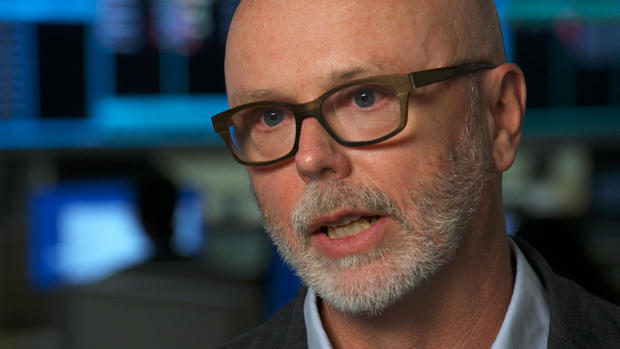
Dr. Michael GardamDr. Michael Gardam: Now at this point, everybody knows about CoVid-19. But it's, it's
not so much now. Now you've pretty much bought whatever PPE you can buy, it's very hard to buy that
anymore. It's what did you do a month and a half ago that was so important. So, none of this is any surprise
to us whatsoever, and yet, you see countries around the world where this has been a surprise
.
BlueDot had no clients in the U.S., so while Dr. Gardam's hospital was making plans in January, President
Trump, as late as March, was still assuring Americans that everything was under control.
California wasn't so sure, and braced for the worst. In March, it became the first state in the country to lock
down its cities. Mickey Mouse suddenly looked lonely, drivers had only dreamed of such empty freeways
But the lock-down bought time. Despite having its first case of COVID-19 five weeks before New York,
California dodged the hurricane of infection that slammed into New York City. At his daily teleconference in
Sacramento, Governor Gavin Newsom made no secret where he'd gotten his edge: outbreak science.
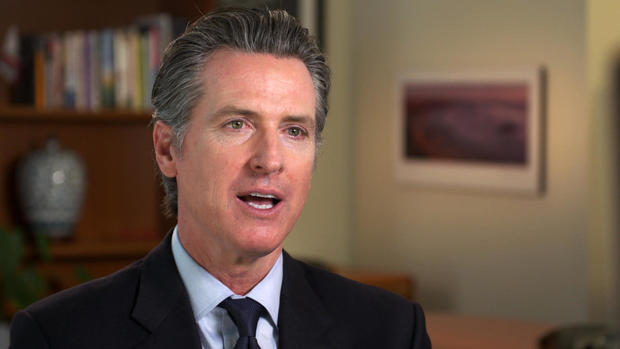
Governor Gavin NewsomGavin Newsom: It's not a gross exaggeration when I say this – the old modeling is
literally pen–to-paper in some cases. And then you put it into some modest little computer program and it
spits a piece of paper out. I mean, this is a whole other level of sophistication and data collection.
With the virus spreading around the world, California enlisted the help of BlueDot, Esri, Facebook and
others, using mapping technologies and cell phone data to predict which hospitals would be hit hardest,
and see if Californians were really staying at home. Data became California's all-seeing crystal ball.
Gavin Newsom: We are literally seeing in to the future and predicting in real-time based on constant update
of information where patterns are starting to occur before they become headlines.
Bill Whitaker: Can you just sort of like, give me an example?
Gavin Newsom: We can see in real time on a daily basis, hourly basis, moment-by-moment basis if
necessary, whether or not our stay-at-home orders were working. We can truly track now by census tract,
not just by county.
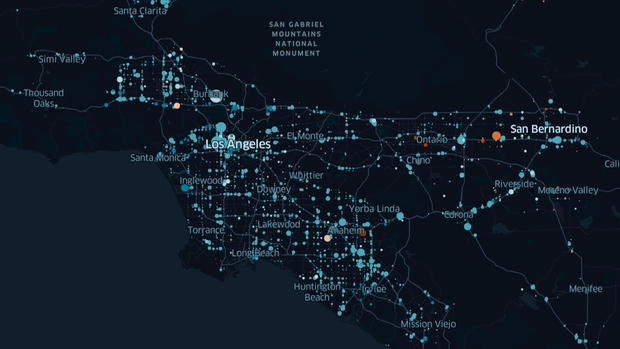
Here's what it looked like. BlueDot scanned anonymous cell phone data over a 24-hour period last month in
Los Angeles. The blue circles indicate less movement than the week before, the red spots show where
people are still gathering. It could be a hospital – or a problem. That cellphone data allows public health
officials to investigate. It also raises worrisome privacy issues.
Bill Whitaker: How are you able to ensure that this cell phone data will remain anonymous?
Gavin Newsom: Well, I didn't want to take the companies' words for it, I say that respectfully. I have a team
of folks that are privacy-first advocates in our Technology Department. And we are making sure that no
individualized data is provided. If it is, we're out.
Bill Whitaker: So what's been the most frustrating part of this for you?
Gavin Newsom: It's just incumbent upon us to have a national lens. And to recognize we're
many parts but one body. And if one part suffers, we all suffer.
Bill Whitaker: From this experience, do you think the Federal Government needs to overhaul the way it
tackles pandemics?
Gavin Newsom: I don't know that there's a human being out there, maybe one or two, that would
suggest otherwise. No, the absolute answer is, of course, unequivocally.
Dylan George: Data technology has transformed the way we do business in many aspects of
our lives.But it has not transformed the way things are done in public health.
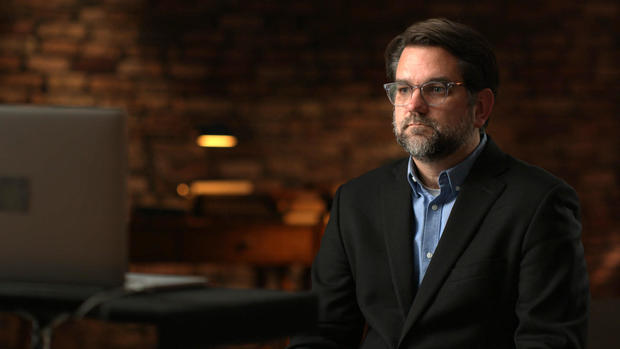
Dylan George For Dylan George that's an urgent priority. As a scientist tracking biological threats in the
Bush and Obama administrations, he has seen first-hand what he calls the panic-neglect cycle
.
Dylan George: Perhaps the most tragic idea in all of public health is this: in a time of an outbreak everyone
lights their hair on fire and is running around trying to figure out. After it's over, everyone forgets about it
He has joined a growing number of scientists pressing to revive an old idea: an infectious disease
forecasting center modeled on the National Weather Service.
Dylan George: We need to have professionals that their day job is dedicated to helping us understand how
infectious diseases will-- will risk our well being economically and from a national security perspective.
Bill Whitaker: That idea has been kicking around for a while. It's never gotten the funding. Do you think
things will be different this time?
Dylan George: When we see that there is $2 trillion being spent on stimulus bills to help us get out of this,
to make sure that we can rebound, we need to think transformatively. We need to think broadly about how
we can move these things forward. This kind of a center would help us do that.
As the coronavirus continues to upend our lives, Toronto's Dr. Michael Gardam told us he has seen the
difference a digital early-warning system can make.
Dr. Michael Gardam: One of the biggest challenges in infectious diseases is you never wanna be the doctor
that picks up the first case because you're probably going to miss it. And you probably weren't wearing the
right gear and it's probably already spread in your hospital. And so getting the early warning that help gives
you the intel to make that first call is so incredibly important.
Produced by Heather Abbott. Associate producer, David M. Levine. Broadcast associate, Emilio Almonte.
Edited by Robert Zimet.
© 2020 CBS Interactive Inc. All Rights Reserved. |











